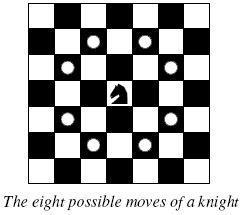poj2488A Knight's Journey
A Knight's Journey
| Time Limit: 1000MS | Memory Limit: 65536K | |
| Total Submissions: 30965 | Accepted: 10596 |
Description
 Background
Background
The knight is getting bored of seeing the same black and white squares again and again and has decided to make a journey
around the world. Whenever a knight moves, it is two squares in one direction and one square perpendicular to this. The world of a knight is the chessboard he is living on. Our knight lives on a chessboard that has a smaller area than a regular 8 * 8 board, but it is still rectangular. Can you help this adventurous knight to make travel plans?
Problem
Find a path such that the knight visits every square once. The knight can start and end on any square of the board.
Input
The input begins with a positive integer n in the first line. The following lines contain n test cases. Each test case consists of a single line with two positive integers p and q, such that 1 <= p * q <= 26. This represents a p * q chessboard, where p describes how many different square numbers 1, . . . , p exist, q describes how many different square letters exist. These are the first q letters of the Latin alphabet: A, . . .
Output
The output for every scenario begins with a line containing "Scenario #i:", where i is the number of the scenario starting at 1. Then print a single line containing the lexicographically first path that visits all squares of the chessboard with knight moves followed by an empty line. The path should be given on a single line by concatenating the names of the visited squares. Each square name consists of a capital letter followed by a number.
If no such path exist, you should output impossible on a single line.
If no such path exist, you should output impossible on a single line.
Sample Input
3 1 1 2 3 4 3
Sample Output
Scenario #1: A1 Scenario #2: impossible Scenario #3: A1B3C1A2B4C2A3B1C3A4B2C4
#include<iostream>
#include<cstdio>#include<cstring>
#include<algorithm>
#include<vector>
#include<stack>
#include<queue>
#include<set>
//#include<map>
#include<cmath>
using namespace std;
typedef long long LL;
const int MAX=0xfffffff;
int vis[30][30];
int x[30],y[30];
int p,q;
int dirx[]={-1,1,-2,2,-2,2,-1,1};
int diry[]={-2,-2,-1,-1,1,1,2,2};
int flag;
void dfs(int a,int b,int num)
{
x[num]=a;
y[num]=b;
if(num==p*q)
{
for(int i=1;i<=p*q;i++)
printf("%c%d",y[i]+'A'-1,x[i]);
printf("\n\n");
flag=1;
return ;
}
if(flag) return ;
for(int i=0;i<=7;i++)
{
int tx=a+dirx[i];
int ty=b+diry[i];
if(!vis[tx][ty]&&tx>0&&ty>0&&tx<=p&&ty<=q)
{
vis[tx][ty]=1;
dfs(tx,ty,num+1);
vis[tx][ty]=0;
}
}
}
int main( )
{
// freopen("1.txt","r",stdin);
int t;
scanf("%d",&t);
for(int kase=1;kase<=t;kase++)
{
scanf("%d %d",&p,&q);
memset(vis,0,sizeof(vis));
flag=0;
printf("Scenario #%d:\n",kase);
vis[1][1]=1; //这句也可以写到dfs中
dfs(1,1,1);
if(!flag) printf("impossible\n\n");
}
return 0;
}
以前不太会写搜索,写多了,发现深搜和广搜一样,算是有模板的